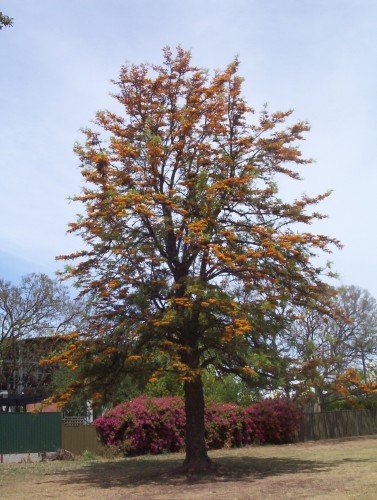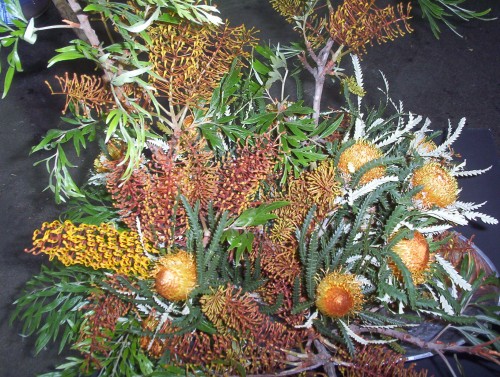Anigozanthos flavidus (Tall Kangaroo Paw)
I have just planted three of these plants. They were quite tight in their pots but were making new shoots so I decided to take a chance and put them in as they were. Mine are a yellow-green colour, but you can also get pink, orange, red, yellow or green, and sometimes mixed colours. The usual colour is the yellow -green
Two have gone onto a raised mound, and the third at ground level but with a dose of gypsum in case there is clay below the root ball. Mounds need only be 120 mm above ground level to achieve the drainage required.
This is the hardiest of the kangaroo paws and is used in breeding the new hybrids that are in many nurseries these days. I must say that I like the species plants even though I admire the new colours.
The strappy leaves on this plant can grow up to a metre tall and the clump to a metre across. However the flower spikes can grow to two metres . The seed I was given came from plants that had these very tall spikes and many flowers on the stalk.
It grows best in moist, light to medium soils, in partial to full sun, but will tolerate dappled shade. It can be damaged by frost.
Black ink disease is a problem in misty areas or locations where there is not enough air movement. Slugs and snails will cause a lot of damage.
Natives for Full Sun and Full Shade
A request for help with a site that was clay soil in full sun in summer and full shade in winter prompted a look through my reference books. I was able to find the following list of plants.
Do what you can to improve the drainage of the clay. Liberal sprinkling with gypsum, at least a Kg per sq metre is required. The rain will wash it in or you can water it in.
Here are some shade loving plants that tolerate full sun, and vice versa! Most of these will require some water in Summer once established, to keep them at their best. A mulch in summer will assist with evening out the soil temperature.
Plants for Full Sun amd Full Shade
Dianella revoluta and Dianella tasmanica are good ones.
Bauera rubioides (will need summer water)
Banksia robur
Boronia denticulata
Brachysema lanceolatum
Callistemon citrinus and forms of this- Anzac, Burgundy, Endeavour, Mauve Mist, Western Glory,
Calytrix tetragona
Senna artemisioides
Chorizema cordatum
Correa decumbens
Correa ‘Dusky Bells’
Correa pulchella forms
Crowea exalata
Crowea saligna
Dampiera diversifolia
Epacris impressa
Eriostemon verrucosus
Grevillea buxifolia
Grevillea lanigera
Hardenbergia violacea any colour
Hibbertia scandens
Kennedia nigricans
Prostanthera ovalifolia (summer water)
Viola hederacea
Salt Tolerant Plants
An email came today asking for assistance with species that would grow in bore water with high salt readings. This is a difficulty for many in the mallee areas of South Australia and no doubt other parts of the country too. In many cases it becomes trial and error to see what would grow in such a situation, but some lists have been compiled by members of the Australian Plants Society which give a good starting point.
There are some things to consider.
- There is a need to ensure that watering is deep.
- Choose plants from areas which have the same rainfall situation ie same amount of rain, at the same time of year. This is to ensure that plants will get minimum exposure to the high salinity.
- If possible place highly desirable plants near an alternative water source, eg rain water, to get them well established without the saline water.
List of Australian Native Plants with salt tolerance.
1st Line Coast
Ground Covers, Climbers and Low Spreading Plants
Correa decumbens
Eremophila glabra prostrate cerise form
Eremopohila glabra prostrate red form
Grevillea ‘Seaspray’
Isolepis nodosa
Leuocophyta brownii
Rhagodia spinescens
Scaevola crassifolia
Templetonia retusa prostrate form
Shrubs 1-2m
Atriplex cinerea
Callistemon rugulosus
Eremophila calorhabdos
Eremophila glabra (Rottnest Island)
Hakea cycloptera
Olearia axillaries
Templetonia retusa
Westringia fruticosa
Shrubs over 2m.
Atriplex nummularia
Callistemon teretifolius
Hakea drupacea
Melaleuca nesophila
More lists will be available soon.
Greviilea robusta in flower
1st and 2nd Line Coast
The making of plant lists for these situations is trickier than I thought. Where does 1st line coast begin and end? The Australian Plant Society has decided that the sea front is 1st line coast. This could be a distance of 50-100 metres from the water. Plants that can be grown need to have tolerance to salt laden winds and salt soil. More tender plants could be planted with the protection of wind break plantings which are tolerant of 1st line coast conditions.
The second street back from the coast is the beginning of 2nd line coastal plantings. The further back from the coast the garden is, the plants can be less tolerant of the salt laden winds, especially with good protection from wind breaks or other barriers.
In some instances, the nature of the soil will also determine the plantings. For example, the soil could be rocky and gravelly, or pure sand dune sand.

